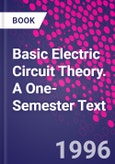This is the only book on the market that has been conceived and deliberately written as a one-semester text on basic electric circuit theory. As such, this book employs a novel approach to the exposition of the material in which phasors and ac steady-state analysis are introduced at the beginning. This allows one to use phasors in the discussion of transients excited by ac sources, which makes the presentation of transients more comprehensive and meaningful. Furthermore, the machinery of phasors paves the road to the introduction of transfer functions, which are then used in the analysis of transients and the discussion of Bode plots and filters. Another salient feature of the text is the consolidation into one chapter of the material concerned with dependent sources and operational amplifiers. Dependent sources are introduced as linear models for transistors on the basis of small signal analysis. In the text, PSpice simulations are prominently featured to reinforce the basic material and understanding of circuit analysis.
Please Note: This is an On Demand product, delivery may take up to 11 working days after payment has been received.
Table of Contents
(Chapter Headings): Basic Circuit Variables and Elements. Kirchhoffs Laws. AC Steady State. Equivalent Transformations of Electric Circuits. Thevenins Theorem and Related Topics. Nodal and Mesh Analysis. Transient Analysis. Dependent Sources and Operational Amplifiers. Frequency Characteristics of Electric Circuits. Magnetically Coupled Circuits and Two-Port Elements. Appendices.Basic Circuit Variables and Elements: Introduction. Circuit Variables. Reference Directions. The Resistor. The Inductor. The Capacitor. Ideal Independent Voltage and Current Sources. Summary. Problems. Kirchhoff's Laws: Introduction. CircuitTopology. Kirchhoff's Laws. Linearly Independent Kirchhoff Equations. Summary. Problems. AC Steady State: Introduction. AC Quantities. Amplitude and Phase Relationships for Circuit Elements. Phasors. Impedance and Admittance. AC Steady State Equations. AC Power. Complex Frequency. Summary. Problems. Equivalent Transformations of Electric Circuits: Introduction. General Series and Parallel Connections. Voltage and Current Divider Rules. Input Impedance. Symmetry. The Superposition Principle. An Introduction to Electric Circuit Simulation with PSpice. Summary. Problems. Thevenin's Theorem and Related Topics: Introduction. Non-Ideal Two-Terminal Circuit Elements. Equivalent Transformations of Non-Ideal Voltage and Current Sources. Thevenin's Theorem. Norton's Theorem. Nonlinear Resistive Circuits. Summary. Problems. Nodal and Mesh Analysis: Introduction. Nodal Analysis. Mesh Current Analysis. PSpice Simulations. Summary. Problems. Transient Analysis: Introduction. First Order Circuits. Second Order Circuits. Transfer Functions and Their Applications. Impulse Respons and Convolution Integral. Circuits with Diodes (Rectifiers). PSpice Simulations. Summary. Problems. Dependent Sources and Operational Amplifiers: Introduction. Dependent Sources As Linear Models for Transistors. Analysis of Circuits with Dependent Sources. Operational Amplifiers. PSpice Simulations. Summary. Problems. Frequency Characteristics of Electric Circuits: Introduction. Resonance. Passive Filters. Bode Plots. Active-RC Filters. Synthesis of Transfer Functions with Active-RC Circuits. PSpice Simulations. Summary. Problems. Magnetically Coupled Circuits and Two-Port Elements: Introduction. Mutual Inductance and Coupled Circuit Equations. Transformers. Theory of Two-Port Elements. PSpice Simulations. Summary Problems. Appendices.








